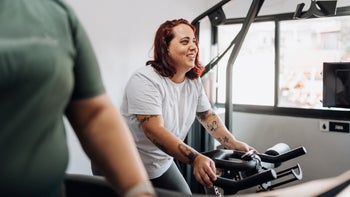
8 Benefits of Walking Backwards That Will Make You Want to Try It
Key takeaways:
Walking backward offers many benefits, including greater strength, balance, and flexibility.
You can try walking backward on a treadmill for 5 minutes before working up to 10- to 20-minute periods.
Talk to a healthcare professional first if you have balance problems or conditions like Parkinson's disease that raise your risk of falls.

Walking is an accessible form of cardio that can help you stay active. But reverse walking challenges your body in unique ways and may help you build strength and flexibility.
Walking backward all day long isn't a good idea. However, adding reverse walking to your exercise routine might be worthwhile.
What are the benefits of walking backwards?
Researchers say that the forward thrust or power during regular walking comes from your ankle. The power during backward walking comes from your hips and knees. This switch-up offers many benefits.
Save over 40% on Qsymia with GoodRx
Discover the once daily Qsymia for weight management. Qsymia is for adults and children 12-17 in combination with a healthy diet and regular exercise.

1. Builds muscle strength
When you walk, your gait or walking pattern is heel-to-toe. So with each step, your heel hits the ground first, followed by your toes. With backward walking, it's the opposite. Your toes hit the ground before your heel. This changes how the muscles work in your hips and legs.
Walking backward has been shown to make your legs work harder than walking forward. For example, as you walk backward, you engage the quadriceps at the front of your thigh to straighten your legs and propel you back. This can help you build lower-body muscle strength. Studies have shown that walking backward enhances quadriceps strength better than forward walking.
2. Improves balance and gait
Walking backward can improve gait, walking speed, and balance, especially after an injury or illness. One review found that when combined with other physical therapy treatments, retro walking improved gait and muscle strength in people with knee osteoarthritis, juvenile rheumatoid arthritis, and ACL injuries.
Another study examined a backward walking training program in people who had a stroke. It improved balance and walking speed better than standing balance training.
A more recent study had similar findings. People recovering from a stroke walked backward on a treadmill for 30 minutes, three times a week. They had better balance, walking speed, and cardiorespiratory fitness in 4 weeks.
3. Burns more calories than forward walking
Because your muscles work harder, reverse walking can help you burn more calories than regular walking. The American College of Sports Medicine (ACSM) found that walking briskly –– at 3.5 miles per hour –– burns 4.3 METs or metabolic equivalents. Walking backward, on the other hand, burns 6.0 METs.
Read more like this
Explore these related articles, suggested for readers like you.
A MET measures how much energy your body uses during physical activity. One MET, for example, is the amount of oxygen you use at rest. So according to the ACSM, reverse walking burns about 40% more calories per minute than walking briskly. This is a great way to raise the intensity of your exercises.
4. Boosts cardiorespiratory fitness
Walking is an excellent form of cardio that can boost your heart and lung health. Walking backward is effective, too. Reverse walking can improve your cardiorespiratory fitness, allowing your heart and lungs to provide oxygen more efficiently during exercise.
In a small study, young women completed a backward walking and running training program. After 6 weeks, they had less body fat and better cardiorespiratory fitness.
5. Increases flexibility and range of motion
Retro walking changes your usual gait, which may improve your flexibility and range of motion and help with aches and pains. When you step backward, your knee straightens before your foot lands. This repeated movement can improve your range of motion if you have trouble extending your knee fully due to injury or illness. It can also boost flexibility in the ankles and hamstrings at the back of the thigh.
6. Helps limit knee pain
Experts say that walking in reverse puts less pressure on the knee joint and kneecaps. It also strengthens the quads, which help support the knee. This may ease knee pain from illnesses or injuries like knee osteoarthritis and runner's knee. That explains why walking backward on a treadmill is one of many techniques that physical therapists use in rehabilitation programs.
The change in walking direction also engages low back muscles that stabilize your spine. Researchers believe this may help people with chronic low back pain.
7. Challenges your brain
Walking backward is good for your brain, too. For many people, walking is an automatic process that doesn't require much thought. But reverse walking challenges you to pay more attention and consciously think about how you move. This can help body awareness as you move.
Learning new things, like mastering the retro walking technique, is one of many ways to keep your brain sharp. A study in Cognition found that people who walked backward — or even thought about it — had better short-term memory of past events.
8. Prevents exercise boredom
If walking is your main source of exercise, walking backward is a great way to change your routine and level up your daily walk. Switching things up can help prevent exercise boredom as you challenge your muscles in new ways. You can also try power walking or Nordic walking.
Regular walking may lower blood pressure. Learn how it helps and how to build a consistent walking plan.
Maybe it’s time to take your walking to the next level. Consider these strategies to boost your walking intensity.
Inactivity increases the risk of chronic health conditions. Try these tips to up your daily step count.
Tips for walking backwards on a treadmill safely
Retro walking outside can be dangerous. So it's best to practice on a treadmill.
Walking backward on a treadmill offers additional benefits, too. For example, it allows you to track your retro walking distance and speed. Most treadmills also have a safety cord that you can attach to your clothes to help prevent accidents or injuries.
Make sure you are comfortable walking forward on a treadmill before you try retro walking. And wear supportive shoes.
Here's how to get started walking backward on a treadmill:
Stand facing the back of a treadmill with your feet on either side of the belt.
Attach the safety cord to your shirt or pants. This will automatically turn off the treadmill if you get too far away or trip.
Start the treadmill or have someone start it for you. Make sure it starts at a slow speed (1 mph).
Hold onto the side rails as you start walking backward.
Focus on reaching your leg back and stepping with a toe-to-heel gait. Roll onto your heel as your knee straightens.
Turn off the treadmill or have someone do it for you when you are done. Keep walking backward until the treadmill stops completely.
Interval training with brief forward and retro walking periods can make for a fun workout. Beginners can practice in 5-minute increments. Then, work your way up to 10 to 20 minutes at a time. Slowly increase the speed to around 2 mph as you become comfortable with reverse walking.
If walking backward on a treadmill is too difficult, start with shorter distances in your home. Find a clear space with a handrail or other steady surface nearby. No matter where you practice, it's a good idea to have someone close by when you try retro walking. Experienced retro walkers can add inclines for a greater challenge.
Who should not try walking backwards without support?
Medical professionals often use reverse walking to measure the risk of falls in people with Parkinson's disease, multiple sclerosis, or a traumatic brain injury. If you have any of these conditions or balance problems, or you are an older adult, talk to a healthcare professional before you try walking backward. They can let you know if the method is safe for you.
You should also check with a healthcare professional if you’ve had recent injuries, surgery, pain, or limited motion. Your professional might suggest practicing retro walking with a physical therapist.
The bottom line
There are many benefits of walking backward, like better balance, strength, and flexibility. Plus, it may keep your brain sharp. Walking backward on a treadmill is the best way to add the method to your fitness program.
Older adults and people with balance problems, recent injuries, or certain conditions should talk to a healthcare professional first. When you get the OK, start slowly and work up to 10 to 20 minutes to get the most from walking backward.
Why trust our experts?



References
Alghadir, A. H., et al. (2019). Effect of 6-week retro or forward walking program on pain, functional disability, quadriceps muscle strength, and performance in individuals with knee osteoarthritis: A randomized controlled trial (retro-walking trial). BMC Musculoskeletal Disorders.
Ansari, B., et al. (2018). Lumbar muscle activation pattern during forward and backward walking in participants with and without chronic low back pain: An electromyographic study. Journal of Chiropractic Medicine.
Balasukumaran, T., et al. (2018). The effectiveness of backward walking as a treatment for people with gait impairments: A systematic review and meta-analysis. Clinical Rehabilitation.
Carter, V., et al. (2019). The 3-m backwards walk and retrospective falls: Diagnostic accuracy of a novel clinical measure. Journal of Geriatric Physical Therapy.
Cha, H. G., et al. (2016). Therapeutic efficacy of walking backward and forward on a slope in normal adults. Journal of Physical Therapy Science.
Chang, K. W., et al. (2021). The effect of walking backward on a treadmill on balance, speed of walking and cardiopulmonary fitness for patients with chronic stroke: A pilot study. International Journal of Environmental Research and Public Health.
Chen, Z., et al. (2021). The efficacy of backward walking on static stability, proprioception, pain, and physical function of patients with knee osteoarthritis: A randomized controlled trial. Evidence-Based Complementary and Alternative Medicine.
Clark, D. J. (2015). Automaticity of walking: Functional significance, mechanisms, measurement and rehabilitation strategies. Frontiers in Human Neuroscience.
Grasso, R., et al. (1998). Motor patterns for human gait: Backward versus forward locomotion. Journal of Neurophysiology.
Lippincott Williams & Wilkins. (2011). 2011 Compendium of physical activities.
Mieth, L., et al. (2019). The ‘mnemonic time-travel effect’. Experimental Psychology.
Rose, D. K., et al. (2018). A backward walking training program to improve balance and mobility in acute stroke: A pilot randomized controlled trial. Journal of Neurologic Physical Therapy.
ScienceDirect. (n.d.). Metabolic equivalent.
Terblanche, E., et al. (2005). The effect of backward locomotion training on the body composition and cardiorespiratory fitness of young women. International Journal of Sports Medicine.
Thomas, K. S., et al. (2018). Graded forward and backward walking at a matched intensity on cardiorespiratory responses and postural control. Gait & Posture.
Whitley, C. R., et al. (2011). Effects of backward walking on hamstring flexibility and low back range of motion. International Journal of Exercise Science.





























